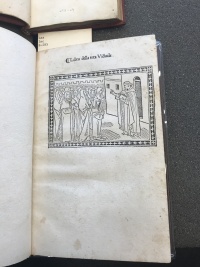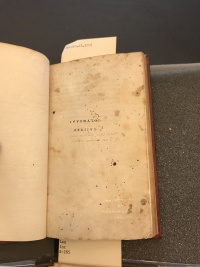Titles/Title Pages/Incipits/Colophons
How do you identify a book? In current times, most people would answer this seemingly obvious question with “the title.” But relatively speaking, the title, and its associated technologies of the title page, incipit, and colophon have only been around for so long; each of these technologies had to be invented. Prior to these inventions, books were designated by other means. For example, clay tablets were designated by numbers, Ancient Hebrew texts by the first few words (comparable to an incipit), and even the ancient oral stories of Greece and Rome were titled after the fact, most likely by scribes or grammarians. [1] Following this age, titling devices were invented, and tracing the trajectory of titles, title pages, incipits, and colophons throughout book history proves valuable not only bibliographically, but when looking toward the current digital incunable age.
History
There are four main ways to identify a book, and each have their own unique place in book history. Incipits derive from antiquity and much like a title, are used to introduce the reader to a text, taking place as the first few words of a text. But unlike the title, incipits employ the author’s voice, and serve as an almost conversational introduction. [2] The incipit was very common in medieval manuscripts and early printed books but has since lost popularity. However, a well-known work, Chaucer’s Canterbury Tales, begins with an incipit, “here begynneth ...” [3] Like the incipit, the life of the colophon traces to antiquity. The colophon contains information about the publication of the book, and prior to the invention of the title page was placed in the back of the manuscript. With the advent of the title page, the colophon moved to the back of the title page. Despite the shift, the colophon remains in existence today, just in different forms than its initial conception. For example, some websites have colophons containing the XHTML. While the existence and use of incipits and colophons has faded due to the inventions of titles and title pages, incipits and colophons still remain important book technologies.
Titles derive from the latin word Titulus, translated as “inscription, label, notice, title of honor, fame, pretext.” [4] Despite the antiquated name, titles were not used in antiquity, instead reaching popularity during the arrival of the printing press. Prior to the printing press, title placement was “haphazard until the appearance of the title page between 1475 and 1480,” with titles previously appearing most often in the colophon. [5] While there is no consensus regarding the inception of titles, which in itself speaks to the initial insignificance of titles, there are theories about why titles and title pages arose. One well-regarded theory asserts that printers would leave blank pages around the books in their shop because they did not want to get them dirty; however, they needed something to identify the books with when giving them to the customers, and thus the title and title page emerged. The title page generally contains a “title, subtitle, author, publisher, and edition”. Title pages arose coincidentally with the printing press, around 1500. Incunables, or “the first printed books,” mark a transitory phase and include parts of medieval manuscripts, such as incipits, as well as the beginnings of modern book technologies, such as title pages. Printers often distributed title pages as flyers to advertise their press. [6] With the regular use of the title page, titles soon became an indelible feature of books as well as an attribute of books that has garnered much scholarly debate.
Scholarly Insights on Titles
Many scholars have written about titles and entitling. The breadth of work on this topic leads to the following conclusion: since there are a great deal of scholarly observations, titles have already accumulated much more intense meaning than their original intent. Circling back to the previously cited theory about the emergence of titles and title pages, it can be assumed that titles did not arise out of an important literary and interpretative need, but rather a functional need, which then grew into interpretative and thematic importance.
Scholars’ interpretation of the function of titles juxtaposes the insignificance of the title’s initial emergence. John Fisher is one scholar who deeply interacted with titles. His thesis on titles states:
“While titles are names, they are a good deal more than just names. They are not necessarily descriptions, although they can contain descriptive elements. They are names for a purpose, not merely for the purpose of identification and designation, in spite of the important practical role which indexical names play in the designative process. The unique purpose of titling is hermeneutical; titles are names which function as guides to interpretation.” [7]
Fisher posits that titles have a deeper purpose beyond just a naming device to aid in the identification of literary works. Titles, according to Fisher, guide readers through the work, allowing them to interpret the work via the title. Fisher’s fellow scholar, Hazard Adams calls titles “marginal,” but adds that “their marginality is central,” agreeing with Fisher that titles have a larger meaning, as “synecdoches,” representing the whole work. [8] Adams also interacts with the Jerrold Levinson’s commonly cited four theses on titles, the first of which is paramount to this important juxtaposition of the contemporary importance of titles despite their inconsequential birth. Levinson’s first thesis advances that “titles of artworks are often integral parts of them, constitutive of what such works are.” [9] While Adams spends much of his paper arguing that Levinson’s first thesis does not go far enough, and that in fact titles of artworks are “always” “integral parts of them,” this argument in and of itself shows how much stamina titles have gained from their initial place in the literary community. [10] Finally, S.J. Wilsmore also claims that titles have an interpretative function, as well as a naming duty. He further argues that a “literary work often possesses its title essentially in that it could not be the same literary work without it.” [11]
Analysis of Objects
Returning to a time when it was nearly impossible to judge a book by its cover, Rare Book Rooms and Special Collections, such as the University of Pennsylvania’s Rare Book and Manuscript Library, demonstrate the transitory qualities of incipits, titles, title pages, and colophons through incunables and early printed books.
An examination of three manuscripts from Penn’s Rare Book and Manuscript Library, allows for a comparison between the role of titles, title pages, incipits, and colophons in the transitory time of printing (around the 1500s). Libro della vita Viduale’s [1490] first identification comes in the form of a title page, home to just this title and an ornate woodcut (Figure 1).


Cataloguers at Penn think it to be by Girolamo Savonarola, but there is no name on the title page. However, Libro della vita Viduale’s incipit announces the commencement of the text as well as the name, Hieronymo, which is thought to be Savonarola (Figure 2). Penn’s catalogue of this work believes its publication to be, Florence : Bartolommeo di Libri, ca. 1490, which was otherwise not denoted in the book. Such information would be typical of the colophon, or back of the title page, but for this incunable no such information exists on the manuscript. However, digitization allows for such information to come to light. Iuuenalis Persius [1501], a very early printed book, follows the tradition of Libro della vita Viduale by having a title page just containing the title (Figure 3). However, on the back of the title page, Iuuenalis Persius contains a note from famous Italian printer, Aldus Manutius, to Scipio, essentially saying that he made a shorter book (Manutius invented a new size format) (Figure 4). In this instance, the title page contains some of its current information as the identity of the printer is known; however, it also demonstrates the liberty of printers during this time. Penn cataloguers believe the publication to be, Venetiis, in dibus Aldi. mense augusto, 1501, which would have otherwise been unknown by just observing the manuscript. Libro della vita Viduale and Iuuenalis Persius were published within eleven years of one another. Both serve to demonstrate the coexistence of the title, incipit, title page, and colophon as identification devices. In addition, both these works are staples of the incunable period as printers and publishers had not yet figured out the standard for identifying the title pages, so the works wound up having a collision of different devices. It is interesting to think about: how would someone have identified these books at the time of publication? By their title pages?

Notes
- ↑ Levin, “The Title as a Literary Genre,” pg. xxiv-xxv.
- ↑ Shevlin, “‘To Reconcile Book and Title, and Make ‘em Kin to One Another,’: The Evolution of the Title’s Contractual Features.”
- ↑ Shevlin, “‘To Reconcile Book and Title, and Make ‘em Kin to One Another,’: The Evolution of the Title’s Contractual Features.”
- ↑ Adams, "Titles, Titling, and Entitlement To," pg 8.
- ↑ Shevlin, “‘To Reconcile Book and Title, and Make ‘em Kin to One Another,’: The Evolution of the Title’s Contractual Features.”
- ↑ Shevlin, “‘To Reconcile Book and Title, and Make ‘em Kin to One Another,’: The Evolution of the Title’s Contractual Features.”
- ↑ Fisher, “Entitling.” pg. 288.
- ↑ Adams, “Titles, Titling, and Entitlement To.” pg. 7.
- ↑ Adams, “Titles, Titling, and Entitlement To.” pg. 9.
- ↑ Adams, “Titles, Titling, and Entitlement To.” pg. 9-10.
- ↑ Wilsmore, “The Role of Titles in Identifying Literary Works.” pg. 408.
Works Cited
Levin, Harry. “The Title as a Literary Genre.” The Modern Language Review, vol 72, no. 4, Published by Modern Humanities Research Association, October 1977, pp. xxiii-xxxvi, JSTOR. https://www.jstor.org/stable/3724776
Shevlin, Eleanor, F. “‘To Reconcile Book and Title, and Make ‘em Kin to One Another,’: The Evolution of the Title’s Contractual Features.” Book History, vol 2, 1999. Johns Hopkins University Press. http://muse.jhu.edu/article/3592
Adams, Hazard. “Titles, Titling, and Entitlement To.” The Journal of Aesthetics and Art Criticism, vol. 46., no. 1, Published by Wiley on behalf of The American Society for Aesthetics, Autumn 1987, pp. 7-21, JSTOR https://www.jstor.org/stable/431304
Fisher, John. “Entitling.” Critical Inquiry, vol. 11, no. 2. The University of Chicago Press, December 1984, pp. 286-298, JSTOR https://www.jstor.org/stable/1343396